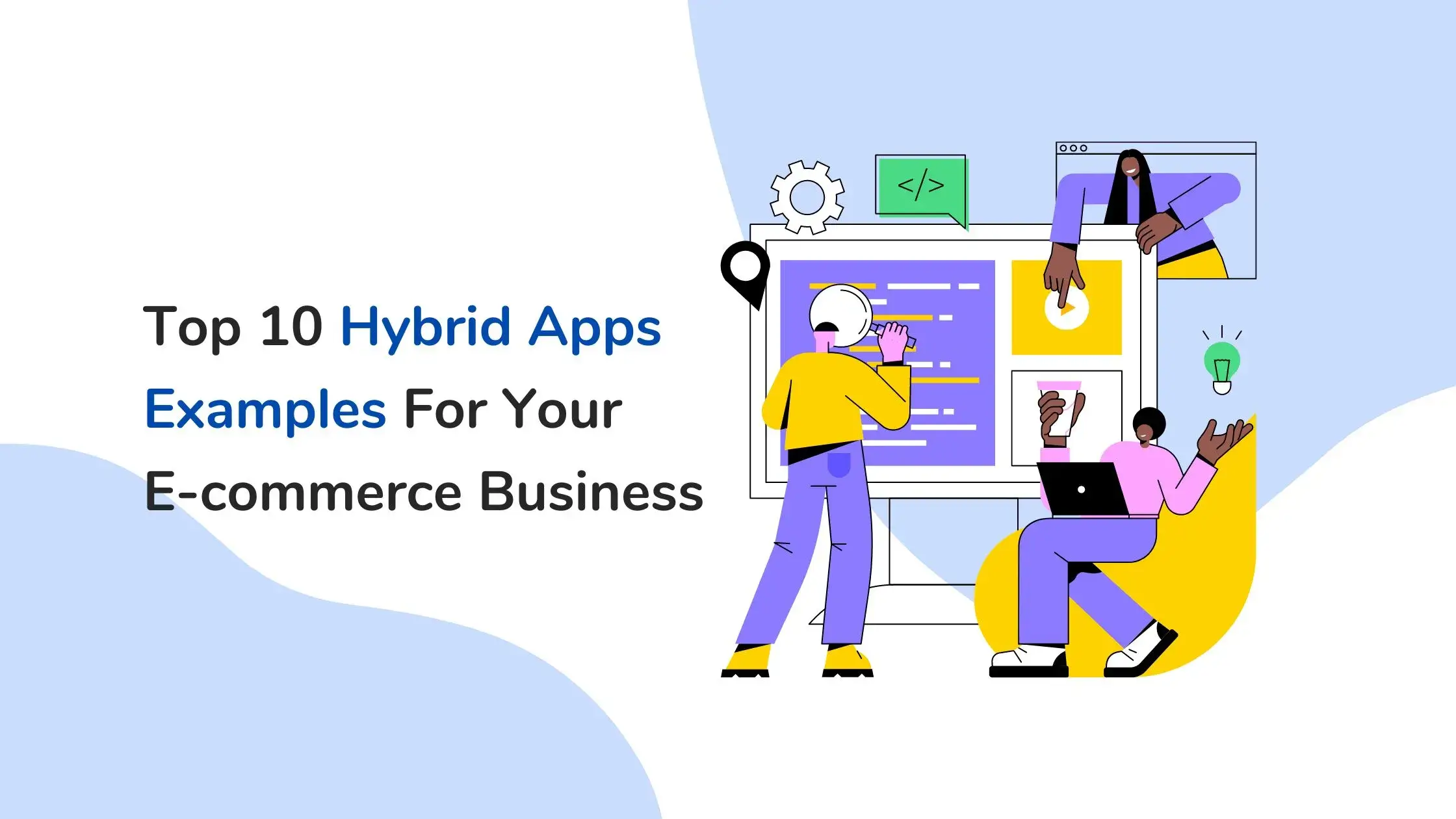Introduction
A hybrid app is created using a single coding language and works on many platforms (for example, an app we can deploy to both iPhone and Android devices). As smartphones have surpassed PCs, laptops, and tablets as the most popular device for accessing digital information, strategies have emerged to speed up mobile app development. Hybrid mobile applications have gained popularity despite being a newer choice on the market.
In 2012, Facebook first offered the idea of a hybrid app. Since then, numerous company models have successfully used this software application. Check out these hybrid app examples if you share their interest. They can help you see the hybrid app’s possibilities more clearly.
Introduction To Hybrid Apps
A hybrid app uses a single codebase to run across several platforms. App Developers can design a single app that we can download from numerous app stores rather than rewriting programs in the native code languages of each operating system. Hybrid solution apps integrate coding languages with integrations and plugins.
Why are Hybrid Apps popular?
Depending on your objectives and goals, a hybrid mobile application may be ideal for your cross-platform app development team needs, especially if affordability and timeliness are your top priorities. One key advantage of creating the software in a cross-platform language rather than two native elements is that it can be released to the market more quickly and cost less to produce in terms of cross-platform development hours.
Benefits of hybrid app development
1. Faster Development
It will take less time to construct your software as you don’t need to create two single code bases if you want it to be available for both iPhones and Android devices. Cross-platform frameworks are the quickest way to create a product that is prepared for the Google Play Store and App Store if you have a brilliant concept ready for the market and are eager to get it out on the app store.
2. Lower Price
Less time spent on development time equals fewer billable hours. Hybrid app development costs will continue to be less expensive than native application development stages as long as it takes fewer hours, as it already does.
3. Wider audience
Due to financial constraints, many businesses release apps to one platform before being released on another. Naturally, this will reduce an app’s user base because consumers cannot download the app while they wait for the operating system of their phones to make it available.
4. Maintenance and bug fixes are simpler
Hybrid apps can fix problems on all devices with a single patch and bug fix. It is simpler than correcting the issue, say, first for iOS and then a second time for Android.
5. Scalability
Hybrid apps scale more quickly since adding new dynamic features is simpler. Waze, a native app, integrated with Android Auto in August 2018 by releasing a feature that allowed users to view the app on their dashboard. However, it didn’t make the same functionality available to iOS users until more than a month later, when it added support for Apple CarPlay.
The Top Examples of Hybrid applications
These are the top hybrid app examples that show a multi-platform framework can deliver seamless performance on par with native apps!
1. Twitter
One of the best examples of hybrid apps is the Twitter app. With 187 million active users, this social networking site is well-known. It is impressive that a multi-platform program can manage such a high traffic volume.
Twitter has several exceptional capabilities, like streaming live content using a mobile device, post Tweets with pals, using the service offline, and offering recommendations.
The limitations of hybrid mobile apps, frequently discussed on tech forums, are hard to identify in the Twitter app, especially the problem with performance issues. Twitter moves quickly and fluidly. Additionally, it saves up to 40% of the user’s app usage data.
2. Gmail
Today, many people check their email daily. For so many people, this is a necessary tool. Are you, therefore, shocked that Gmail is a hybrid app?
Gmail has given the market for cross-platform applications a fresh viewpoint. It is a request for a reliable email service. It has millions of downloads right now from app stores.
The hybrid app development framework of HTML5 is partly responsible for Gmail’s success. With a variety of useful, straightforward device features and functionalities, it has improved the user experience.
It offers consumers a similar user experience regardless of the mobile platform they use to log in. Still, it also has several noticeable device features that are inferior to native apps. For instance, the support of multiple accounts, automatic spam prevention, message classification, etc.
3. Evernote
Despite what many people think, Evernote is not a native features app. It is a hybrid note app that performs quite well.
The success of Evernote today is a result of the extensive effort its advantage developers put into building its features, security, and simple user interfaces. With camera capture and scanning, automatic data synchronization, self-design, discussion, and note sharing, it can provide users with the most help possible.
This program includes great features and interfaces and a strong security system. Evernote uses firewalls and VPNs to protect users on mobile devices. It even has the TOTP and Google Authenticator apps to confirm users’ identities.
Evernote’s functionality and performance are comparable to any native code software.
4. Instagram
Another trending social network is the next hybrid app on this list, Instagram, a cross-platform app.
Instagram can get millions of hits every day, much like Twitter. It makes certain that each user enjoys a wonderful experience.
Users can utilize this application online and offline thanks to the web technology source code and its native cover. Offline, they can still text, upload photographs, and publish stories.
Additionally, Instagram’s features are potent. For instance, IGTV for longer-than-a-minute videos, Instagram Reels for shorter videos, texting capabilities, Stories for daily happenings of a personal nature, creative tools, etc.
5. JustWatch
It is a hybrid app for TV streaming services. It can stream media from well-known websites, including Netflix, Dish Network, Amazon Prime, and others. Its function as a program that locates internet videos from multiple sources and streams them to you is well understood.
Right now, it has millions of monthly active users. It is a fantastic illustration of a hybrid app with fast performance.
6. Baskin Robbins
Due to its welcoming, simple-to-use, and top-notch user interface, Baskin Robbins is a well-known hybrid application.
The Baskin Robbins app uses the most recent technology to behave like a native app. Even while offline, this application responds to user actions quickly.
Additionally, Baskin Robbins updates happen more frequently due to the hybrid app’s straightforward codebase structure. On the app, promotions and events are updated frequently.
7. Remote POS
In contrast to most items on this list, Remote POS is intended for commercial use. With this application’s help, we may manage restaurant operations with just one phone.
Businesses may use most of their functionalities offline because of its hybrid technology. When printing bills for customers, they need an online connection when necessary.
This program also offers advanced local storage and cloud storage features.
8. Uber
Uber is one of the most impressive examples of a hybrid app. This well-known website enables people to reserve cars. To give their customers the finest experience, hybrid app developers provide access to many intricate features. Identifying users, supplying drivers’ pictures, offering a variety of payment channels, etc.
Additionally, this hybrid application is quick, precise, and simple. Customers may now easily find the proper driver, the car they require, and the payment they need.
Even when compared to native apps, Uber was once regarded as one of the apps with the fastest loading times.
9. Amazon Appstore
Amazon Appstore is a platform for selling applications similar to Apple App Store, and its source code is written in HTML5.
Amazon’s decision to choose a hybrid and native app are motivated. They desire a user-friendly interface and a dependable experience for their application.
The Amazon Appstore also features excellent search functionality, a straightforward checkout procedure, and a well-designed customer review section.
Conclusion
In recent years, multi-platform frameworks have grown in popularity. In addition to the hybrid app examples we provided, many more companies have successfully used the technology. It demonstrates the enormous capacity and potential of this application type. If you’re looking to develop an application, our team of developers will help you build applications that meet your business needs.
FAQs
Why do you use the term “hybrid apps”?
A hybrid app combines a web app with a lightweight native app “wrapper” to access native platform capabilities and hardware that a web application cannot (such as a smartphone’s camera, calendar, push notifications, and pinch and spread functionality).
What are hybrid and native apps?
In essence, native apps are created by those standards since they are native to the user’s OS. At their heart, hybrid applications are simply web pages wrapped in a native interface.

Priyadharshini K.R is a professional blogger with over 3 years of experience who works at Squash Apps. She is dedicated to providing high-quality content to help clients get more visibility on the search engine result pages. She works hard to boost her clients’ online presence through various content writing services. Hailing from Erode, she is passionate about helping people understand content marketing through easily digestible materials.


